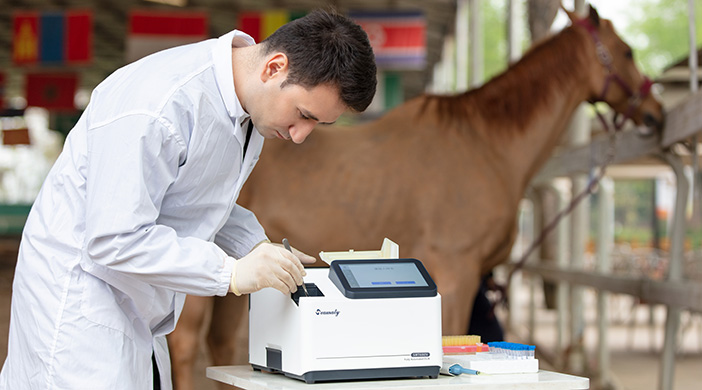
Veterinary hygiene
Veterinary hygiene is the practice of maintaining clean and sanitary conditions to promote the health and welfare of animals, prevent the spread of diseases, and ensure the safety of animal products. It encompasses a wide range of activities and protocols that are essential in veterinary clinics, farms, animal shelters, and other settings where animals are kept.
Key Concepts in Veterinary Hygiene
1. Sanitation and Disinfection
- Sanitation: Routine cleaning to remove dirt, debris, and organic matter that can harbor pathogens. This includes cleaning animal housing, feeding equipment, and surfaces.
- Disinfection: Use of chemical agents to kill or inactivate pathogens on surfaces and equipment after cleaning. Common disinfectants include bleach, quaternary ammonium compounds, and hydrogen peroxide.
2. Biosecurity
- Isolation: Keeping sick or newly introduced animals separate from the healthy population to prevent disease spread.
- Quarantine: A period of isolation for new or returning animals to ensure they are disease-free before joining the main population.
- Visitor Control: Limiting and monitoring access to animal areas to reduce the risk of introducing diseases.
3. Waste Management
- Manure Handling: Proper storage and disposal of manure to prevent contamination of water sources and spread of pathogens.
- Dead Animal Disposal: Safe and sanitary methods for disposing of dead animals, such as incineration, rendering, or composting.
Hygienic Practices in Different Settings
1. Veterinary Clinics and Hospitals
- Sterilization: Ensuring surgical instruments and equipment are sterile to prevent infections. This includes using autoclaves and other sterilization methods.
- Personal Protective Equipment (PPE): Wearing gloves, masks, gowns, and other protective gear to prevent disease transmission between animals and humans.
- Cleaning Protocols: Regular cleaning and disinfection of examination rooms, surgical suites, kennels, and waiting areas.
2. Farms and Livestock Operations
- Milking Hygiene: Ensuring that milking equipment and udders are clean to prevent mastitis and contamination of milk.
- Feed and Water Hygiene: Providing clean and uncontaminated feed and water to animals. Regularly cleaning feeding and watering equipment.
- Pasture Management: Rotating pastures to prevent overgrazing and reduce parasite load.
3. Animal Shelters and Boarding Facilities
- Cage and Kennel Hygiene: Regular cleaning and disinfection of animal housing to prevent disease spread among resident animals.
- Vaccination and Health Checks: Ensuring all animals are vaccinated and regularly checked for health issues.
- Parasite Control: Implementing measures to control fleas, ticks, and other parasites.
Disease Prevention and Control
1. Vaccination Programs
- Routine Vaccinations: Administering vaccines to prevent common infectious diseases in animals, such as rabies, distemper, and parvovirus.
- Herd Immunity: Vaccinating a significant portion of the animal population to reduce the overall prevalence of diseases.
2. Parasite Management
- Deworming: Regular deworming schedules to control internal parasites like roundworms and tapeworms.
- Ectoparasite Control: Using topical treatments, sprays, or oral medications to control external parasites like fleas, ticks, and mites.
3. Zoonotic Disease Control
- Education and Training: Teaching staff, farmers, and pet owners about zoonotic diseases (diseases that can be transmitted from animals to humans) and how to prevent them.
- Hygiene Practices: Encouraging good hygiene practices, such as hand washing after handling animals, and using PPE when necessary.
Hygienic Measures for Animal Products
1. Milk Hygiene
- Pasteurization: Heating milk to a specific temperature to kill harmful bacteria without affecting nutritional quality.
- Milk Storage: Proper cooling and storage of milk to prevent bacterial growth and spoilage.
2. Meat Hygiene
- Slaughter Practices: Ensuring animals are slaughtered humanely and hygienically to prevent contamination of meat.
- Meat Inspection: Regular inspection of meat for signs of disease or contamination before it reaches consumers.
3. Egg Hygiene
- Egg Collection: Collecting eggs frequently and handling them carefully to prevent breakage and contamination.
- Egg Washing: Washing eggs to remove dirt and pathogens from the shell surface.
Advanced Practices in Veterinary Hygiene
1. Hygienic Design of Facilities
- Ventilation Systems: Ensuring proper airflow and ventilation to reduce the buildup of ammonia, dust, and pathogens.
- Drainage Systems: Designing facilities with proper drainage to prevent water stagnation and contamination.
2. Antimicrobial Stewardship
- Judicious Use of Antibiotics: Using antibiotics only when necessary and following veterinary guidance to prevent the development of antibiotic-resistant bacteria.
- Alternative Treatments: Exploring alternative treatments and preventive measures to reduce reliance on antibiotics.
Challenges and Future Directions
1. Emerging Diseases
- Monitoring and Surveillance: Keeping track of emerging diseases and pathogens to implement timely preventive measures.
- Research and Innovation: Investing in research to develop new vaccines, treatments, and hygienic practices.
2. Climate Change
- Impact on Disease Patterns: Understanding how climate change affects the spread and prevalence of diseases.
- Adaptive Measures: Developing strategies to adapt to changing environmental conditions that impact animal health.
Conclusion
Veterinary hygiene is a critical aspect of animal care that ensures the health and well-being of animals and the safety of animal products. By maintaining high standards of cleanliness, implementing effective biosecurity measures, and practicing responsible disease prevention and control, veterinarians and animal caregivers can significantly reduce the risk of disease outbreaks and improve the overall quality of animal husbandry. As challenges like emerging diseases and climate change continue to evolve, ongoing research and adaptation of hygienic practices will be essential to safeguard animal and public health.




